Wolfenstein: The New Order – Review
by Mark R

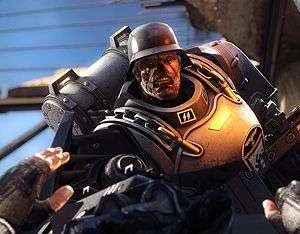 As a long-time player of real-time and turn-based strategies and, more recently, a bit of a western role-playing fanatic, one would be forgiven for thinking that I’m not exactly au fait with the first or third-person shooter genre. That would certainly be true of the more recent franchises as my time with Call of Duty pretty much turned me off shooters for life, and playing Battlefield 3 at ‘one of those event things’ left me stone cold. In fact, the closest I’ve really come to playing a shooter would be Borderlands which, as anyone who has played it knows, lacks the precision and forethought of most other titles in the genre and mostly involves keeping the fire button depressed whilst running around like a lunatic, hoping for a more powerful gun with which to run around like a loon with the fire button pressed. Ad infinitum.
As a long-time player of real-time and turn-based strategies and, more recently, a bit of a western role-playing fanatic, one would be forgiven for thinking that I’m not exactly au fait with the first or third-person shooter genre. That would certainly be true of the more recent franchises as my time with Call of Duty pretty much turned me off shooters for life, and playing Battlefield 3 at ‘one of those event things’ left me stone cold. In fact, the closest I’ve really come to playing a shooter would be Borderlands which, as anyone who has played it knows, lacks the precision and forethought of most other titles in the genre and mostly involves keeping the fire button depressed whilst running around like a lunatic, hoping for a more powerful gun with which to run around like a loon with the fire button pressed. Ad infinitum.
The truth is, I’m a child of the arcades. In between pouring all of my non-earned pocket money into Smash ‘n’ Grab with the hopes of perhaps winning the huge £3 jackpot, I would also have days where I’d avoid the flashing lights and melons of the money pits entirely and immerse myself in Operation Wolf, clutching the machine gun as though I were ripped straight out of The Wild Geese. In fact, I loved Operation Wolf so much that I bought it as my first shooter for the Amiga. This ultimately led me to Wolfenstein 3D, and I was immediately smitten. It wasn’t so much about tearing through level after level, firing off round after round, and instead had more of a cerebral fix where every round was precious and stealth was the key to staying alive with what few resources were available.
When the opportunity arose to take a look at Wolfenstein: The New Order at E3 2012, I passed it up. This was in part due to my new-found nonchalance with regard to the genre itself, but also because modern remakes tend not to float my boat and are, in fact, more likely to sink it entirely. Wolfenstein 3D was a great game when it came out, and the earlier additions to the franchise did nothing for me while the 2009 release sparked zero interest. This time around, however, it was going to be different and I had to take this one for a ride. And what a ride that turned out to be.
 Stepping once again into the presumably huge shoes of franchise regular, B J Blazkowicz, we are thrust into the trenches of World War II where the Nazi war machine was trundling forth with more power than ever before, thanks to advanced technology. Where once stood Panzer tanks now lay mechanised mutts going by the name of Panzerhunds, along with walking towers of destruction with feet capable of flattening entire buildings. This was a Nazi force unlike any in our history – this was General Wilhelm “Deathshead” Strasse’s regime. After failing to destroy Deathshead’s stronghold, Blazkowicz and two of his comrades are captured and you are forced to make a choice between killing your pilot, the beautifully foul-mouthed Fergus Reid, or the wet-behind-the-ears new guy, Private Probst Wyatt III. Whichever decision you make here dictates how the game plays out as killing Wyatt provides you with a hot-wiring perk whereas having Reid killed will open the ability to pick locks.
Stepping once again into the presumably huge shoes of franchise regular, B J Blazkowicz, we are thrust into the trenches of World War II where the Nazi war machine was trundling forth with more power than ever before, thanks to advanced technology. Where once stood Panzer tanks now lay mechanised mutts going by the name of Panzerhunds, along with walking towers of destruction with feet capable of flattening entire buildings. This was a Nazi force unlike any in our history – this was General Wilhelm “Deathshead” Strasse’s regime. After failing to destroy Deathshead’s stronghold, Blazkowicz and two of his comrades are captured and you are forced to make a choice between killing your pilot, the beautifully foul-mouthed Fergus Reid, or the wet-behind-the-ears new guy, Private Probst Wyatt III. Whichever decision you make here dictates how the game plays out as killing Wyatt provides you with a hot-wiring perk whereas having Reid killed will open the ability to pick locks.
As one would expect, Deathshead never planned to let anyone survive and orders the death of the remaining two. During escape, Blazkowicz suffers a serious head injury, and a beautifully shot set piece plays out where fourteen years pass as he swims in and out of consciousness in a Polish asylum in a vegetative state, watching inmates come and go, and witnessing murders at the hands of the visiting Nazis. It is here that he becomes acquainted with the rather fetching nurse, Anya, whose father runs the asylum. As luck would have it, on the day that the Nazis decide to shut down the asylum by murdering all the inmates, kidnapping Anya and killing her parents, our man in Krakow breaks free of his vegetative state and we are once again in control of our protagonist.
 |
 |
 |
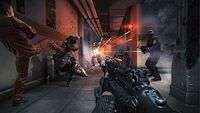 |
 |
 |
What follows is an incredibly well made game which stays true to its roots in more ways than most rekindled franchises would. First of all, the weapon drops from the enemies are pretty limited in that you’ll invariably find that they all drop the same gear so if you’re looking for a minigun or chaingun then you’re in for a long wait. The same could be said for the handgun or marksman rifle, as these are only ever dropped by the same unit types and they rarely appear. To that end, those who love to snipe from afar or who prefer to hold their ground as thousands of large-calibre rounds burst forth from a handheld Gatling will have a long wait and have no choice but to get used to the Nazi ‘Gun Of The Month Club‘ favourite – the assault rifle.
 While many would argue that this could hinder gameplay, it does make for a more realistic experience than many non-historical shooters would offer and when you do finally get hold of your weapon of choice, you’re far more likely to think tactically rather than blow your load early. This considered approach is perhaps one of the greatest hooks for Wolfenstein: The New Order as it extends the more discerning player the option to think their way out of situations rather than the typical run-and-gun affair where you’re encouraged to expend as much ammo as possible, secure in the knowledge that there’s going to be another huge resource drop around every corner.
While many would argue that this could hinder gameplay, it does make for a more realistic experience than many non-historical shooters would offer and when you do finally get hold of your weapon of choice, you’re far more likely to think tactically rather than blow your load early. This considered approach is perhaps one of the greatest hooks for Wolfenstein: The New Order as it extends the more discerning player the option to think their way out of situations rather than the typical run-and-gun affair where you’re encouraged to expend as much ammo as possible, secure in the knowledge that there’s going to be another huge resource drop around every corner.
For those who prefer to make less of a scene, The New Order‘s stealth mode makes for a more exciting option as every room has to be surveilled to see who will be where at what time before finally stepping into the action, picking each person off with a silent takedown from behind using a knife. The adrenaline surge to be had from this approach was more intense than firing off rounds from behind cover, running to the next available weapon drop, and popping up again to take another few down. Instead, using a silenced handgun to dispatch any commanders to prevent them from raising the alarm and alerting reinforcements means that it’s then easier to stealth around the room to kill every possible unit, leaving only the heavily armoured which must then be taken out using meatier weaponry. Going with the typical shoot-first-ask-questions-later approach in such scenarios invariably results in a room full of angry Nazis, where avoiding the heavy fire from the armoured troops while simultaneously trying to eradicate as many units as possible, generally results in a premature death.
As well as having a great stealth option, the cover mode is actually pretty damned tight. Not being one for using cover systems, as I’ve always found them to be clumsy and capable of killing the immersion quicker than Stan Lee turning up in a Marvel movie, I was hesitant to make use of the feature but once I did I genuinely enjoyed it. Rather than the simple ‘duck behind cover’ and ‘fire from behind cover’ mechanics, The New Order allows for very fluid and intuitive approach where the field of movement is almost spherical in that you can manoeuvre yourself to look around much more effectively than in any other shooters I’ve played. It meant that hanging out in a ventilator shaft tended not to result in a nasty surprise when dropping out, as the cover system allowed for a decent view, making it a joy to use.
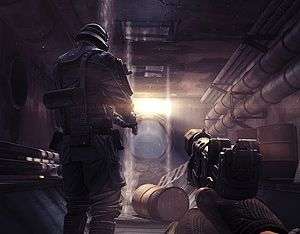 Another joy was the passive perk system. As one who tends to spend more time mulling over advancement options than actually playing the game, it was a breath of fresh air to just get on with playing through and letting the game itself decide which perks to offer, based entirely on my gameplay style. Even after taking a look at the perks screen, ever sceptical as to whether the engine was smart enough to really understand me or not, I came away from the other columns with the attitude of “yeah, I would have picked those had I been given the choice” and that, for me, is a sign that the developers put a lot of thought into just allowing the player to get on with it rather than breaking immersion by having them suddenly stop and spend experience points.
Another joy was the passive perk system. As one who tends to spend more time mulling over advancement options than actually playing the game, it was a breath of fresh air to just get on with playing through and letting the game itself decide which perks to offer, based entirely on my gameplay style. Even after taking a look at the perks screen, ever sceptical as to whether the engine was smart enough to really understand me or not, I came away from the other columns with the attitude of “yeah, I would have picked those had I been given the choice” and that, for me, is a sign that the developers put a lot of thought into just allowing the player to get on with it rather than breaking immersion by having them suddenly stop and spend experience points.
The greatest aspect of Wolfenstein: The New Order, however, is the characterisation. There are no lengthy cut scenes where histories are explained or where you get to play out nightmarish memories which drive the protagonist. Instead, their story is told through expressions and carefully placed themes. An example would be when Frau Engel is handed a baby by a prisoner being led into the camp, and is asked to help it as it’s dying. Her response is to hold it upside down in disgust by the foot, dangling it like a shit-stained handkerchief before ordering its immediate death which, thankfully, is obscured as someone in front’s head gets in the way to block the view. The intake of breath from Blazkowicz tells us as much about him as the way he looks at Anya does, and the quirky humour helps to drive home the more ‘normal’ aspect of his personality, along with his dreams of a future with his new-found love.
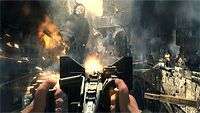 |
 |
 |
 |
 |
 |
One aspect of the characterisation which stood out was the script and, in particular, the voice acting. Almost as soon as the game starts, Fergus Reid’s (Gideon Emery) Scots colloquialisms such as ‘bawbag’ cut through the tension and serve to lighten some of the more intense moments. While many may think this sort of banter is out of place in a life-threatening scenario, as a Scot I can say without fear of contradiction that this is exactly how it would have played out had some rugged Glasgow shipyard worker been in charge. Both Becker and Deathshead (voiced by Bonita Friedericy and Dwight Schultz, respectively) had some fantastic lines to deliver and handled them beautifully, and the inner monologue delivered by Brian Bloom as Blazkowicz resonated long after the credits rolled.
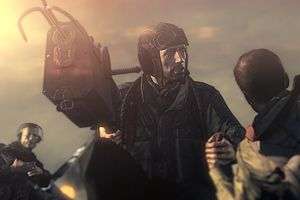 As with games such as Fallout, the story of the world itself is told through audio recordings, newspaper clippings and even overheard discussions so there’s never any momentary lapse where gameplay is overridden by jarring exposition. This, combined with the aforementioned characterisation, is one of the main reasons that I personally enjoyed The New Order as much as I did. I wanted to see the progress, I wanted to see how the lives of the others would play out, and I was genuinely overjoyed when Blazkowicz told Becker he was sorry about her legs and she retorted with “Don’t be; I’ve learned how to fly” as the helicopter took to the sky with a rousing soundtrack. Moments like these make games.
As with games such as Fallout, the story of the world itself is told through audio recordings, newspaper clippings and even overheard discussions so there’s never any momentary lapse where gameplay is overridden by jarring exposition. This, combined with the aforementioned characterisation, is one of the main reasons that I personally enjoyed The New Order as much as I did. I wanted to see the progress, I wanted to see how the lives of the others would play out, and I was genuinely overjoyed when Blazkowicz told Becker he was sorry about her legs and she retorted with “Don’t be; I’ve learned how to fly” as the helicopter took to the sky with a rousing soundtrack. Moments like these make games.
For the collector, there are numerous sets to collect – artefacts, Enigma code pieces, permanent health upgrades, and weapon advancements. As expected, these play a part in the achievements and trophies, and the Enigma codes can later be deciphered to unlock specially designed gameplay modes such as Uber difficulty with 999 health points and unlimited ammo, for one. Just like with the original Wolfenstein games, these collectibles are rarely in plain sight and must be found by examining the surroundings and taking calculated risks with vents and other hidden areas. As they’re not actually necessary in order to successfully complete the game, it’s possible to stay true to the objectives and ignore any immersion-breaking collectathons.
Ultimately, what we have with Wolfenstein: The New Order is one hell of a surprise from beginning to end. The standard WWII fare is quickly dispensed with, a retro-futuristic backdrop is introduced along with a set of great characters – new and familiar – and the story of “what if the Nazis had won the Second World War?” is played out from the perspective of one guy who wants the world to be a better place. It’s not an unfamiliar tale by any means, but the way it’s told, and the characters who help to weave the rich tapestry all serve to make for a truly enjoyable ride. One which, at its conclusion, may leave the player wanting more.
Pros- Excellent, and appropriate, dialogue
- Great voice acting and characterisation
- The 'alternative war ending' was surprising and very well written
- Combat worked well
- Stealth worked even better
- Passive perks helped to retain immersion
- Cover system was very fluid
- Old school brought up to date
- Would have liked to know more about Klaus and Max
- Moon base was a bit out of place
- Some boss weaknesses aren't as apparent as they could be, but it only takes a couple of deaths to discover the strategy
Wolfenstein: The New Order is one of those surprises where you may enter into it with some trepidation and are quickly reassured that it's not going to be a typical run-and-gun affair. The alternate setting where the Nazi regime won the way was expertly handled with a strong enough storyline to support the 'what if?' aspect, although having a moon base did seem a little too far fetched.
The characterisation, voice acting, and script are certainly stand-out points and come together to drive the story at exactly the right pace, and at no time did any of the cut scenes seem shoe-horned in. The Nazi atrocities were handled well, showing the extremes they'd go to but with enough respect for the player to not necessarily show everything and only hint as some aspects.
All in all, Wolfenstein: The New Order was more than just a cracking romp. It was immersive enough to have hours disappear in moments, leave some lasting memories, crack more than a few smiles, and is worthy of the Wolfenstein name.
Last five articles by Mark R
- From Acorns to Fish
- Alone In The Dark
- Why Borderlands is Better Than Borderlands 2
- Falling Short
- The Division: A Guide to Surviving the Dark Zone Solo


























Great write-up, I’m just as in love with this game as you appear to be.
My first ever proper PC game was actually Return to Castle Wolfenstein, which I still dust off now and then, and this game perfectly rekindles everything that was right with that game.